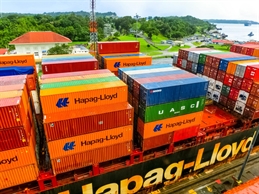
The coronavirus pandemic continues to be a drag the shipping industry, with some of the world’s largest ocean carriers expecting more blank sailings as they struggle to match capacity with continuing weak demand in the market.
Members of The Alliance – Hapag-Lloyd, Ocean Network Express, Yang Ming and Hyundai Merchant Marine – have recently announced adjusted schedules for July through September, which include several merged services and voided sailing schedules, especially for the Asia-North Europe trade.
“In light of the extraordinary impact of the Covid-19 pandemic, the members of The Alliance will adjust schedules for July, August and September for the Asia-North Europe trade and July for the remaining trades, in order to match market demand,” the shipping group said.
The Alliance has a market share of 11% in terms of TEUs.
Its latest announcement included merged schedules between Asia and North Europe, as well as 24 new blank sailings on Asia-Mediterranean; trans-Pacific (west and east coasts); Asia-Middle East; Asia-India; and trans-Atlantic trades.
The Alliance has already cancelled at least 20% of Asia-North Europe sailings between February and June, according to data from maritime and supply chain intelligence firm eeSea.
Separately, Sea Intelligence said as of the end of April, the number of blanked sailings had reached 435 as a drop in demand persisted. The voided sailings indicate a drop in demand equivalent to 7 million TEUs, it added.
Recovery in the second-half
Hong Kong-based container shipping and logistics service OOCL told Asia Cargo News that the recovery in demand will largely depend on how the Covid-19 situation develops.
“Many of the blank sailings are indeed directly related to the low demand caused by the Covid-19 situation around the world,” an OOCL spokesperson said, noting that there are many possibilities and many factors at play which makes it very difficult to forecast for the long-term.
“The rapidly changing and fluid environment makes it very difficult to determine how well and when the markets will recover, but everyone is hopeful for some positive indicators for a rebound sometime in the second half of the year, if not earlier.”
For OOCL, many of the major East-West trade routes have been impacted by the current global pandemic.
The Hong Kong line said, however, that since the beginning of the Covid-19 outbreak, it has made necessary moves to maintain the agility of its operations, to “quickly adapt” to the constantly evolving Covid-19 environment and “stay ahead of the competition.”
“We remain very confident with our performance in deploying our business continuity strategy and leveraging our robust IT infrastructure to ensure we are able to operate seamlessly and effectively while staying in close touch with our customers,” OOCL said.
Meanwhile, the spokesperson said that as the coronavirus situation continues to evolve, it is “too soon to tell” what the net effect to the shipping industry is going to be — although there are already early indications of the extent of the impact. OOCL cited, for example, an Alphaliner report indicating that the inactive containership fleet is standing at 441, which is equivalent to approximately 2.40 million TEUs.
Sea Intelligence said in late April that the cancelled sailings due to the worldwide coronavirus outbreak have already “reached its scheduled peak,” although ocean carriers could still implement more blank sailings to push the peak out further until shippers see demand return.
DHL in its Ocean Freight Market Update for June 2020 said the inactive containership fleet has surged to a new record of 524 units for 2.65 million TEUs as of May 11, accounting for 11.3% of the total containership fleet capacity, although this figure includes 71 units (659,600 TEU) that are currently undergoing scrubber retrofits.
“The inactive fleet is expected to continue to climb in the coming weeks, with the impact of the blanked sailings due to the Covid-19 pandemic still to be fully reflected in the ship idling numbers. All size segments have been hit by the depressed demand,” it said.
The Port of Los Angeles said in May that it expects weak volumes moving in the coming months as ocean carriers announce more blank sailings.
“As we move deeper into the remainder of the second quarter, we’re forecasting significantly lower volumes, particularly on the import side. There are at least 28 voided vessel sailings. Retailer orders are soft as consumer purchasing and confidence has dropped precipitously,” said Gene Seroka, Port of Los Angeles executive director, as the port saw a 6.45% decrease in volumes in April.
Meanwhile, the Port of Rotterdam said in an online briefing that it expects volumes to gradually recover in the next few months as the gateway recorded a 25% capacity decrease so far.
“In the coming months, volumes will gradually increase. It will not go back to normal right away,” said Alexander Philipsen, business manager containers, Port of Rotterdam, as he noted that the pandemic will push the supply chain to diversify and turn more “regional.”



